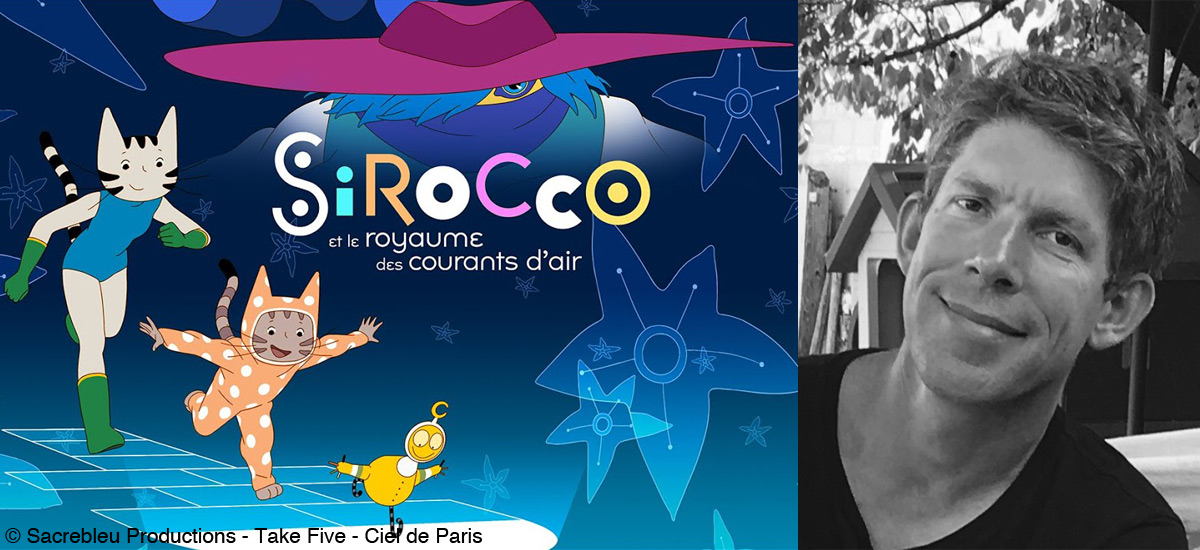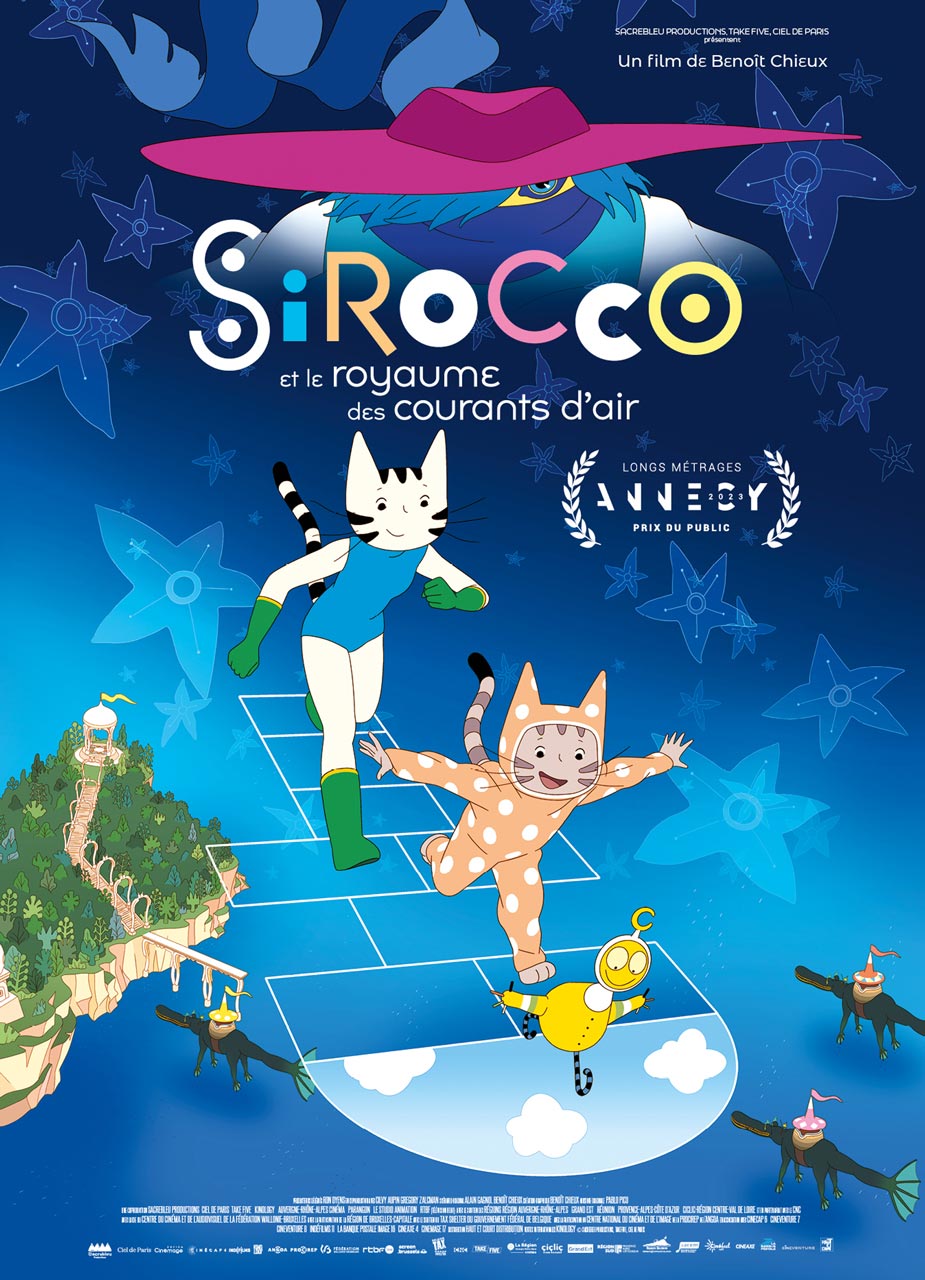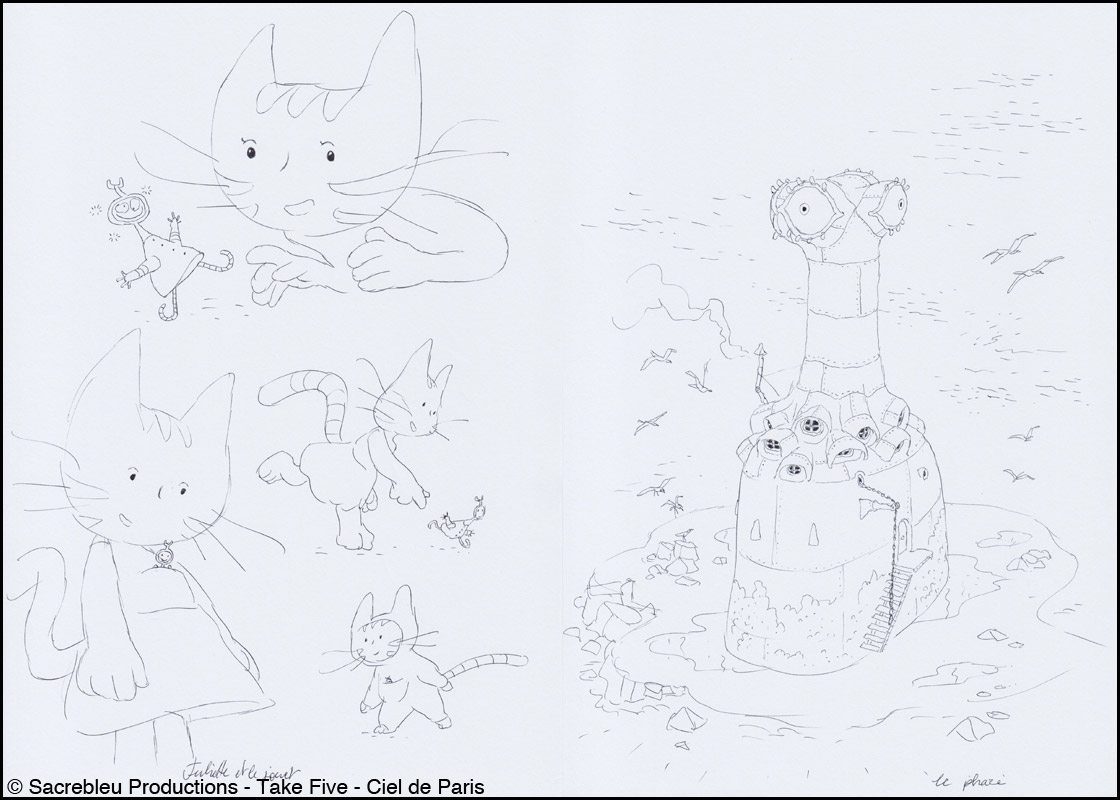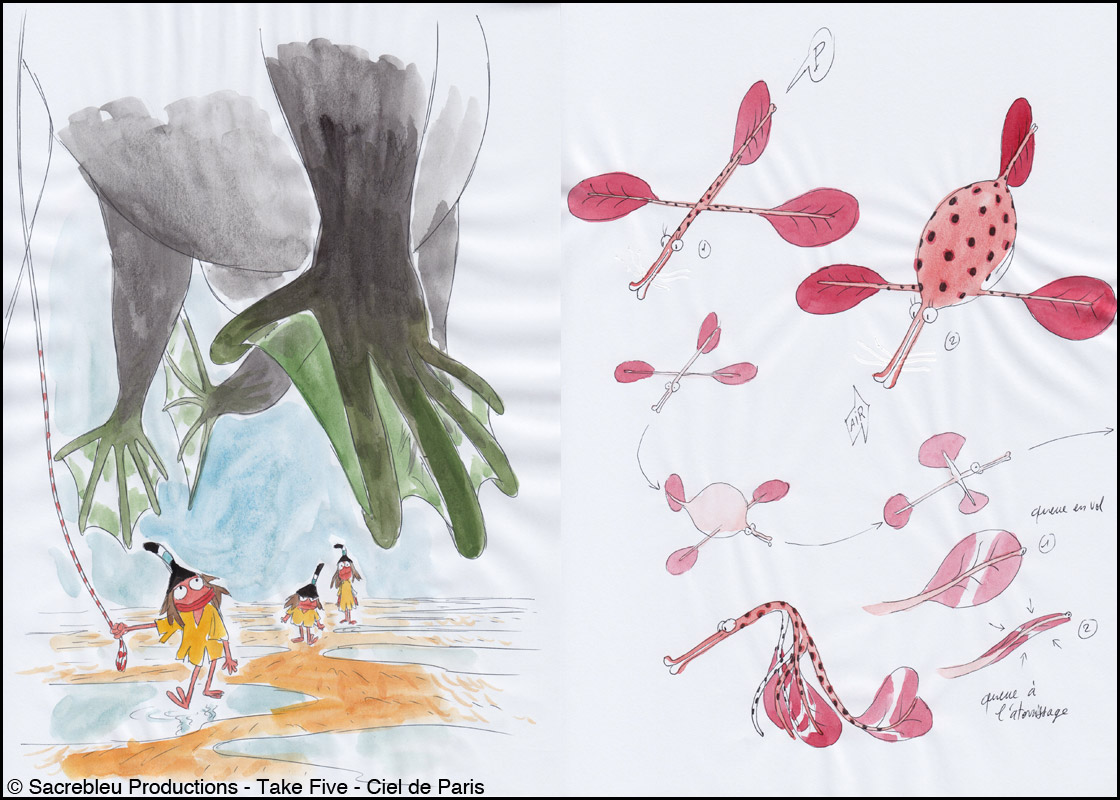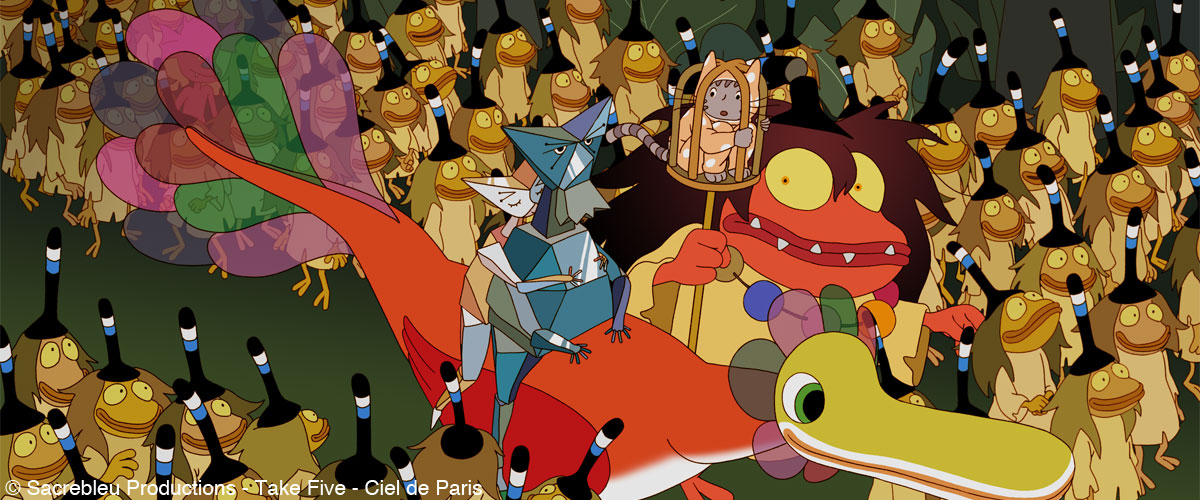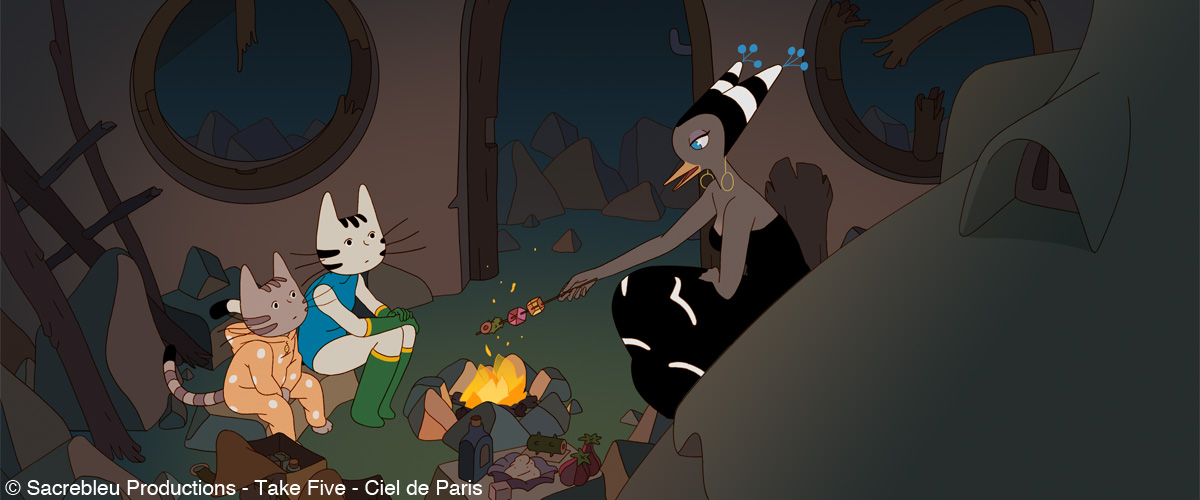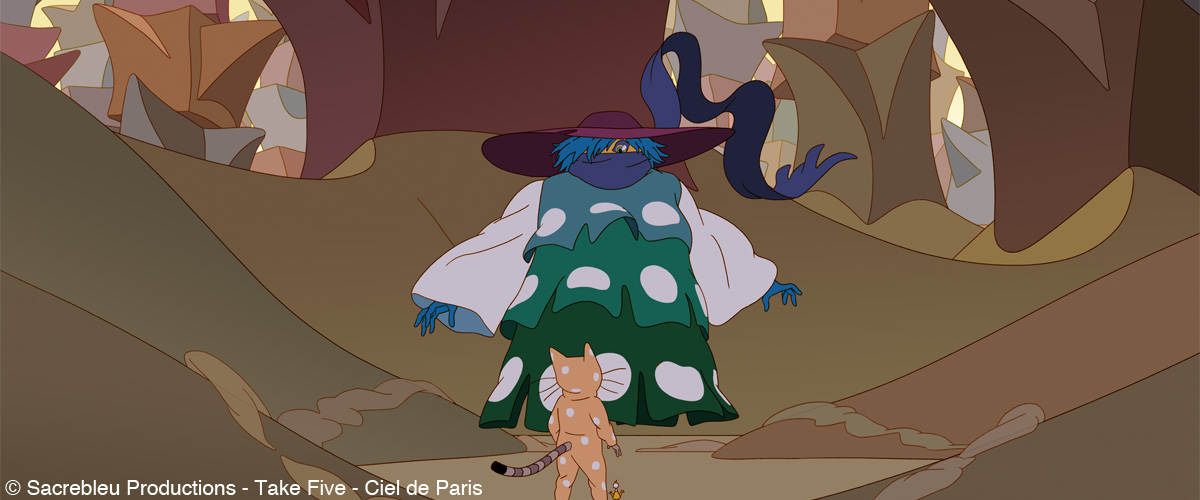Synopsis
Juliette (4 years old) and Carmen (8 years old), two intrepid sisters, discover a passage between their world and the extraordinary universe of their favourite book: the kingdom of the winds. Transformed into cats at their arrival, they are imprisoned and separated by the mayor of the village following Juliette’s clumsiness. Juliette is offered as a pet to Selma, a singer with whom the mayor is secretly in love, and Carmen is sentenced to marry his son, a desperately lonely teenager. Thanks to Selma, the two girls will find each other. But how will they manage to come back to their world? Only Sirocco, who Selma once knew, may help them. But is he as terrifying as the villagers think and that the book implied?
Film credits
Director: Benoît Chieux
Scriptwriters: Benoît Chieux and Alain Gagnol
Main Producer: Ron Dyens (Sacrebleu Productions, France)
Co-Producers: Cilvy Aupin (Ciel de Paris, France) and Gregory Zalcman Take Five (Belgium)
Music: Pablo Pico
Production: Ron Dyens and Claire Burnoud (Sacrebleu Productions, France)
Technique: 2D digital
Running time: 01 h 16 min
We would like to share with you insightful words from Benoît Chieux on the story behind Sirocco and the Kingdom of the Winds, a beautiful 2D animation feature film of a dreamy and touching fantasy adventure. The film won the Audience Award at Annecy international animation film festival 2023 and has been nominated for AniMovie (feature film competition) at upcoming ITFS 2024 (23rd – 28th April).
You can also read the stories behind Sirocco and the Kingdom of the Winds from the main producer Ron Dyens at Cartoon Movie 2020 when the film project was in the early stages from here.
Interview with Benoît Chieux
Hideki Nagaishi (HN): I would like to ask you four questions relating to how you created this adventure story set in an epic fantasy world. Firstly, where did the initial idea of this film story come from?
Benoît Chieux: The initial idea came from drawings. My first drawing showed a windmill torn from the ground by the wind, carrying away two children. Then I drew Sirocco and Selma and part of the world of the kingdom of currents. It was on the basis of these drawings that Alain Gagnol wrote a script. The universe then became clearer as the writing progressed. Quite quickly, the main challenge was to show the wind, how to show the invisible? How do you bring the air, the breathing, the singing, the storm to life, both visually and in the story?
HN: How did you create the story’s universe: the settings and origins of the unique fictional world, fantastic landscapes, and various unique creatures?
Benoît Chieux: It’s a drawing game, you have to let yourself be surprised but also draw a lot and throw a lot away. For example, I drew the flying crocodile quite quickly, but it took me a while to find its final shape. I like simple, legible shapes but it can sometimes take a long time to find the right design and say: that’s it!
I also imposed certain constraints on myself, such as drawing characters without legs. Steps in animation are very difficult to do and it was a very creative way of creating new characters and new forms of animation.
Another constraint was to design without shadows. Large areas of solid colour are very rare in cinema and it was very satisfying to see, but we had to find tricks to create depth in the sets. For example, by lightening the line in the distance.
In Sirocco, line and colour are very important and I wanted to use as few computer effects as possible, which often age very badly. I’m very proud of the result, the whole team worked very hard to find the right balance.
HN: What did you take care in the most or what do you think are the keys to make the story attractive and epic during the story development?
Benoît Chieux: I don’t know the methods for making a story attractive but I wanted the world, the settings and the secondary characters to be very important. I wanted to create a very immersive universe that would plunge the viewer into a wonderful and believable world. I asked Alain Gagnol to leave room for moments of contemplation to enjoy this new world.
Obviously the plot was also very important and the film became much stronger when Selma became Agnès’ sister, one living in an imaginary world and the other in the real world, both separated by a tragic event. This melancholy tone permeates the whole film, giving it a colour that is quite rare in a children’s film. While the visuals are very colourful and cheerful, the tone of the story is sometimes serious and grave, and this contrast was very interesting.
The temperaments of the two little sisters, Juliette and Carmen, are very different, complementing and opposing each other, which brings the story to life. Sirocco’s ambiguous personality was a way of creating suspense. The fact that he’s masked and mysterious creates a very high level of expectation; the audience can’t wait to find out who’s really behind the mask.
HN: What kinds of difficulties did you face during your journey to complete the film’s entire story and how did you deal with them?
Benoît Chieux: The difficulties were the tight deadlines and budget. We made the film in a year and a half, which is very short for a French film. We had to be very efficient and find the best solutions, particularly for the animation. For example, we limited the number of drawings per animator and sometimes simplified the intentions. The working days were very busy for me and for the whole team. The choice of graphics, without shadows and deliberately simple, was also an effective way of saving time. I think the result is very coherent and of a high quality. It wouldn’t have been possible without an artistic and financial team that was totally committed to the film, and I’d like to thank them for that.
HN: I would like to ask you two questions about co-writing with Alain. Firstly, what kind of roles did the two of you share in creating the story?
Benoît Chieux: As I said, Alain Gagnol wrote a script based on a series of drawings that I did very freely, the main theme of which was the wind. It was he who structured the story, a bit as if he’d invented the missing pieces of a jigsaw puzzle. The writing process was quite long, but I always drew in parallel so that I could quickly imagine what the film might look like. For example, it was essential to draw the storm at the end or the shape of the hang-glider to be able to move forward with the writing. The universe was so bizarre that Alain had to be able to see what I had in my head.
HN: What was particularly impressive in terms of Alan’s creativity or creative methods or creative processes? And what kind of charm and splendor did Alan bring to the story?
Benoît Chieux Alain is a very efficient and organised person. He’s an accomplished writer and director, and his personal universe is very close to detective fiction and sometimes quite dark. I was particularly impressed by the way he put himself at the service of the project and respected the visual universe I’d created, which was very different from what he usually does. It was a very pleasant time working with him.
HN: There are various pieces of music with strong presence in multiple scenes throughout the film. I felt those songs emphasize the atmosphere of each scene and they represent the emotions of the characters well. I felt that they frequently work as triggers to excite audiences by allowing them to anticipate upcoming scenes.
Could you please let us know how you achieved to prepare pieces of music that really fit with the story, with Pablo Pico? And what part of the collaboration with Pablo were especially impressive for you?
Benoît Chieux Pablo Pico was involved in the project very early on. We had agreed to give the film a melancholy tone that was close to Paul Grimault’s film The King and the Bird. He very quickly composed a few themes that I used to create the animation. For other parts I used ‘sample’ music, notably borrowed from John Williams. When it came to the recording, Pablo had to replace this ‘reference’ music, which wasn’t easy!
Pablo’s strength is that he knows how to write very simple and very beautiful musical themes that convey a very strong atmosphere in just a few notes. We’d decided to have an orchestral score, which was a first for him, but I got the impression that he’d always done that, he was very quick and very efficient. Writing for 40 musicians is not for everyone.
The most impressive piece was the opera, sung by Célia Kaméni. I wanted a revisited, strange opera, in keeping with the bizarre world of the kingdom of the draughts. I gave him instructions about the intentions for the stage, particularly the importance of breathing and singing, but I didn’t have a precise direction – I had to invent. Pablo Pico managed to find just the right mix I was looking for, and the result is truly surprising, unexpected and spellbinding.


